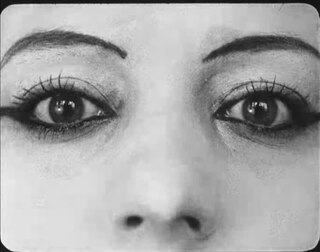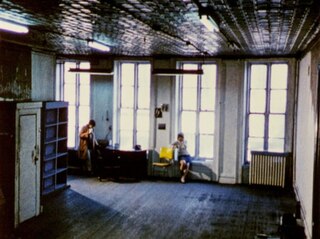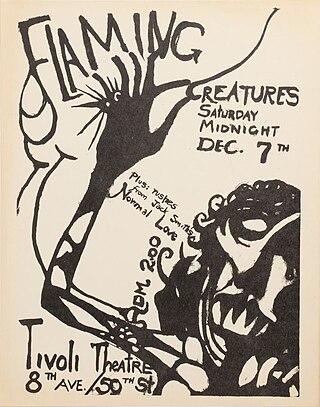
Experimental film or avant-garde cinema is a mode of filmmaking that does not apply standard cinematic conventions, instead adopting non-narrative forms or alternatives to traditional narratives or methods of working. Many experimental films, particularly early ones, relate to arts in other disciplines: painting, dance, literature and poetry, or arise from research and development of new technical resources.

Wavelength is a 1967 experimental film by Canadian artist Michael Snow. Shot from a fixed camera angle, it depicts a loft space with an extended zoom over the duration of the film. Considered a landmark of avant-garde cinema, it was filmed over one week in December 1966 and edited in 1967, and is an example of what film theorist P. Adams Sitney describes as "structural film", calling Snow "the dean of structural filmmakers."

Flaming Creatures is a 1963 American experimental film directed by Jack Smith. The film follows an ensemble of drag performers through several disconnected vignettes, including a lipstick commercial, an orgy, and an earthquake. It was shot on a rooftop on the Lower East Side on a very low budget of only $300, with a soundtrack from Smith's roommate Tony Conrad. It premiered April 29, 1963, at the Bleecker Street Cinema in Greenwich Village.
Gregory J. Markopoulos was a Greek-American experimental filmmaker.

Nathaniel Dorsky is an American experimental filmmaker and film editor. His film career began during the New American Cinema movement of the 1960s, when he met his partner Jerome Hiler. He won an Emmy Award in 1967 for his work on the film Gauguin in Tahiti: Search for Paradise.
Peggy Ahwesh is an American experimental filmmaker and video artist. She received her B.F.A. at Antioch College. A bricoleur who has created both narrative works and documentaries, some projects are scripted and others incorporate improvised performance. She makes use of sync sound, found footage, digital animation, and Pixelvision video. Her work is primarily an investigation of cultural identity and the role of the subject in various genres. Her interests include genre; women, sexuality and feminism; reenactment; and artists' books. Her works have been shown worldwide, including in San Francisco, New York, Barcelona, London, Toronto, Rotterdam, and Créteil, France. Starting in 1990, she has taught at Bard College as a Professor of Film and Electronic Arts. Her teaching interests include: experimental media, history of the non-fiction film, and women in film.
Luther Price (pseudonym) was an experimental filmmaker and visual artist.
Hours for Jerome (1980–82) is an American silent experimental film in two parts directed by Nathaniel Dorsky recording the daily events of Dorsky and his partner, artist Jerome Hiler, around Lake Owassa in New Jersey and in Manhattan. The two films revolve around the four seasons with Part 1 revolving around spring through summer while part 2 revolves around fall through winter. According to Dorsky, he states that the film "is an arrangement of images, energies, and illuminations from daily life" and a "silent tone poem".
The 53rd New York Film Festival was held September 25 – October 11, 2015.
All My Life is a 1966 American experimental short film directed by Bruce Baillie. It shows a continuous shot of a fence, soundtracked by Ella Fitzgerald's 1936 debut single "All My Life". Film critic P. Adams Sitney identified it as an early example of what he termed structural film.
Variations is a 1998 American short silent avant-garde film directed by Nathaniel Dorsky. It is the second film in a set of "Four Cinematic Songs", which also includes Triste, Arbor Vitae, and Love's Refrain.
Side/Walk/Shuttle is a 1991 American avant-garde film directed by Ernie Gehr. It shows downtown San Francisco as seen at different angles from a moving elevator.
The Arboretum Cycle is a seven-part film cycle by American experimental filmmaker Nathaniel Dorsky. The films—Elohim, Abaton, Coda, Ode, September, Monody, and Epilogue—were shot in 2017 at the Strybing Arboretum in San Francisco. Dorsky made the series to capture the interaction between light and plants in the garden.
Triste is a 1996 American avant-garde short film directed by Nathaniel Dorsky. It is the first in a set of "Four Cinematic Songs", which also includes Variations, Arbor Vitae, and Love's Refrain.
Music Makes a City is a 2010 American documentary film directed by Owsley Brown III and Jerome Hiler. It examines the history of the Louisville Orchestra.
Alaya is a 1987 American avant-garde short film directed by Nathaniel Dorsky. It shows sand filmed in different ways.
17 Reasons Why is a 1987 American avant-garde short film directed by Nathaniel Dorsky. Working with a collection of secondhand portable cameras, Dorsky used the unslit 8 mm footage to create a split screen with four quadrants. Normally screened on 16 mm film at 16 frames per second, it is one of his only works to have been shown as a digital transfer.
Pneuma is a 1983 American avant-garde short film directed by Nathaniel Dorsky. It captures grain patterns from unexposed film stocks.
The Illiac Passion is a 1968 American avant-garde film directed by Gregory Markopoulos.
Eniaios is a 22-part silent avant-garde film by Gregory Markopoulos, completed in 1991 and released in parts starting in 2004. The film is made from previous released and unreleased films by Markopoulos, arranged into 22 orders totaling 80 hours of footage. An extensive restoration effort on the film began several years after Markopoulos's death in 1992, and as prints of each order have been created, they have been presented in an ongoing premiere, taking place every four years at a remote site near Lyssarea, Greece.





